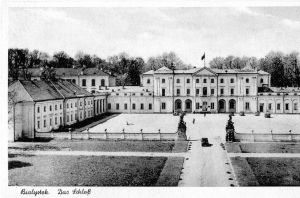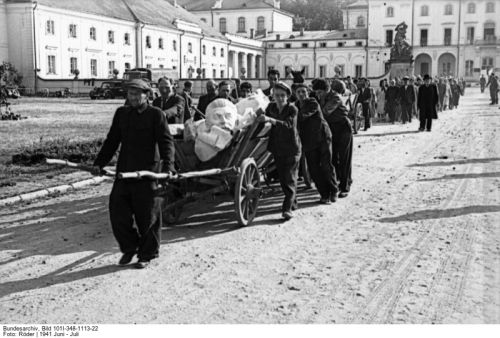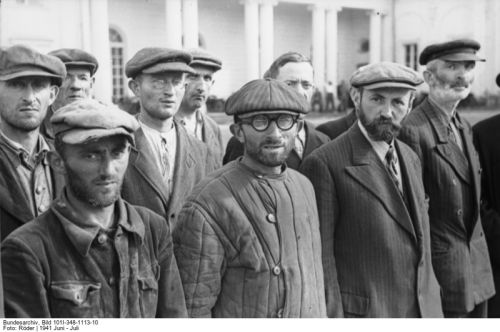Bialystok

Bialystok - German Castle
Bialystok lies 118 miles northeast of Warsaw. Its 1936 population of 99,722 included 44,482 Jews. The Jews had transformed Bialystok into a leading manufacturing centre, with the second-largest textile industry in pre-war Poland. The Germans occupied Bialystok from 15 September 1939 to the 22 September 1939, before withdrawing and leaving it to Soviet rule as part of the Molotov-Ribbentrop Pact and as a result the Jewish population was increased to approximately 50,000 with an influx of refugees from the Generalgouvernement.
The Germans recaptured Bialystok on 27 June 1941, following the start of ‘Barbarossa, the so-called campaign against the Soviet Union and on that day members of Police Battalion 309 removed hundreds of Jews from their homes and executed them in the public gardens. They also brutally murdered patients in the Jewish hospital and another 800 Jews were driven into the Great Synagogue, which was set on fire and those inside were burned alive. On 3 July 1941, Einsatzkommando 8, a sub-unit of Einsatzgruppe B, rounded up approximately 1,000 Jews and shot 300 of them, mostly intellectuals, near Pietrasze, a village just north of Bialystok. On 12 July 1941, the Germans arrested about 4,500 young Jewish men, and members of Police Battalion 316 executed them in a forest near Pietrasze. On Sunday, 29 June 1941, the local German military authorities ordered Gedaliah Rosenman, the chief rabbi of Bialystok to establish a 12-member Jewish Council (Judenrat) within 24 hours. Rosenman formally served as its chairman. However, the practical responsibilities of the chairmanship were assumed by Ephraim Barash, the administrative director and president of the Bialystok Jewish community. The council was expanded to 24 people in August 1941. The Judenrat was ordered to create a Jewish Order Service in August 1941, under the command of Yitzhak Markus. On 26 July 1941, the Judenrat announced that the military authorities had ordered that a ghetto be established and had given the Jews five days to move there. The ghetto was located in an area immediately north of Kosciuszko Square. The Germans ordered the Jews to construct a 2.5 metre –high wooden fence, topped with barbed wire, around the ghetto.
On 1 August 1941, the main gate on, Jurowiecka Street was closed on its 430,000 inhabitants. A Jewish police force of more than 200 men patrolled the ghetto from the inside and helped the Judenrat maintain order and carry out German orders. The Schutzpolizei guarded the ghetto gates from the outside. Waldemar Magunia the German chief of the Civilian Administration served as the ghetto administrator, overseeing the economic activities, whilst members of the Security service, exercised day to day control. From August 1941, the commander of the police and SD in ‘Distrikt Bialystok’ was Wilhelm Altenloh. Until October 1942, he carried out his responsibilities from Allenstein, in East Prussia. His deputy in Bialystok was Theodor Paeffgen. In April 1942, when the SD, Criminal Police and Gestapo in Bialystok were united in a single operational framework, Altenloh was appointed Kommandeur der Sicherhietspolizei und des SD (KdS). The first commander of the Bialystok Gestapo was Waldemar Macholl. Richard Dibus was its deputy commander. From October 1942, Fritz Friedel was head of the Department of Jewish Affairs. When Lothar Heimbach was named Gestapo chief in January 1943, Macholl became his deputy, and Friedel assumed direct responsibility for the ghetto. In September 1941, the German authorities demanded the Judenrat provide a list of 4,500 to 5,000 Jews to be moved to the ghetto in Pruzana. The expulsions stirred popular anger because the Judenrat had targeted for removal, widows of recent victims, and the Jewish Police used force to remove them. Even though Barash had acted harshly, in a show of strength of his authority, he and the other Judenrat members felt enormous responsibility for the residents of the Bialystok ghetto. They established a very large administrative staff to care for them.

Bialystok During the German Occupation
By June 1942, the Judenrat employed more than 4,000 people, not including circa 8,600 industrial workers employed in the ghetto factories. The Supplies Department supervised bakeries, a dairy farm, and factories which produced for the ghetto residents a range of processed foodstuffs, including jam, and transformed inedible meat provided by the authorities into sausage. It grew 190 tons of vegetables in gardens planted on vacant lots and distributed rations, including barley, flour, potatoes, sugar, oil, wood and coal. The fact that the Judenrat initially ordered the ghetto inhabitants to burn potato peels to save on refuse collection, perhaps indicate that the Bialystok ghetto was better provided than most. A Welfare Department opened an old-age home for 200 residents and organised two orphanages. The Health Department established a hospital and provided the ghetto population with free or reduced-cost medical services, included standard vaccinations for children. A Sanitation Department imposed harsh penalties to prevent the outbreak of disease. The morbidity rate in the first year of the ghetto’s existence nonetheless climbed to almost double the rate before the German occupation, but the cleanliness drives, also prevented a single case of typhus in the ghetto. Barash maintained that Jewish survival depended on transforming the Bialystok ghetto population into a productive source of cheap labour to meet the vital economic needs of the German Reich. He believed his strategy would protect the Jews from German violence, forestall deportations and ensure Jewish survival. The surviving reports of the Judenrat meetings indicate that its guiding principle was – as Barash put it – ‘to make the ghetto so useful to the German administration that it would be detrimental for them to destroy it.’
By June 1942, twenty factories operated in the Bialystok ghetto. A laundry, a glass-polishing workshop, sewing rooms, a tannery, and leather works also had been created. They manufactured a long list of items, including clothing and uniforms, shoes, saddles, barrels, electrical appliances, soap, chemicals, furniture, and bandages. To produce the finished products, most shops initially depended on raw materials, such as glass and ultimately potato peels, mainly collected in the ghetto. The largest orders came from the Wehrmacht. The Bialystok ghetto laundry, for example, reportedly cleaned the soiled clothes, uniforms, and bed sheets of every Wehrmacht unit on the Eastern Front. Private German companies and the German civil administration also ordered goods and services from the ghetto workshops and factories. In early October 1942, the Reich Main Security Office in Berlin ordered the Security Police in Bialystok to evacuate 12,000 Jews from the ghetto. However, several local German officials, including Friedrich Brix, the deputy head of the civil administration, appealed to Berlin to spare the ghetto because of its importance to the war production. When the Germans began on 2 November 1942, to liquidate all of the provincial ghettos in ‘Distrikt Bialystok’, the Bialystok ghetto was untouched. However, as a result of the liquidation ‘Aktion’ in early November 1942, control of the ghetto passed to the Security Police and Gestapo. Barash also ceded about 25,000 square metres of land in the ghetto, including most of Zamenhof and Zydowska Streets and some of Biala, Bransk and Polna Streets. The Germans used the dwellings there to house some 5,000 Poles and Belorussians expelled from the Bialowieza Forest area, with the latter brought there to take the place of Jewish workers, should they be deported to the extermination camps. Barash curbed the excesses of the Jewish Police, on 16-17 June 1942, the Judenrat ordered 20 corrupt policemen to be sent to labour camps. When a search on 21 June 1942, of the apartment of policeman Grisha Zelikowicz, a notorious extortionist, revealed large sums of foreign currency, diamonds, furs and other valuables, the Judenrat ordered him to be turned over to the Gestapo. Barash appointed the popular Moshe Berman, a pre-war deputy chief of police in Bialystok , to fill the position of commander of the Jewish police. Berman restored the force’s public image, in part by recruiting policemen with a social conscience. The changes ultimately created a force that refused to help the Germans extricate Jews from their hiding places during the mass deportations. The young people of Bialystok, from a wide range of pre-war political movements organised resistance. In December 1941, the Communists established the first Underground organisation, known as the Anti-Fascist Committee.
In early January 1942, two groups of activists from Vilna arrived in the Bialystok ghetto. The first from Hehalutz Ha- Za’ir Dror was led by Mordechai Tenenbaum, who himself continued on to Warsaw. The second from the Ha-Shomer Ha-Za’ir included Hajkah Grosman, a native of Bialystok, sent from the United Partisan Organisation (FPO), to establish a similar organisation to co-ordinate resistance. Her efforts failed because the Communists refused to abandon their traditional of ideological isolation. Co-operation between Dror and Ha-Shomer Ha-Za’ir also did not move forward smoothly, as Dror had not yet made armed struggle the focal point of its activities. In August 1942, news of the mass deportation ‘Aktion’ in the Warsaw ghetto and a split among the Communists enabled Edek Boraks from the Ha-Shomer Ha-Za’ir to unite a part of the Underground. His block, ‘Front A’ joined together the Communists, Ha-Shomer Ha-Za’ir and a faction of Bundist youth. In November 1942, Tenenbaum returned to Bialystok, determined to establish a cohesive fighting organisation. His efforts faltered because the Communists still refused to co-operate with Dror, who they believed followed a heretical ideology, and who were too close to the Judenrat. Seeing no alternative, in late January 1943, Tenenbaum consolidated a second resistance block known as ‘Front B’. It consisted of Dror, Betair, Hanoar Hasioni and a Bundist group that had not joined ‘Front A’. Ha-Shomer Ha-Za’ir members operated in both fronts, providing the link between the two blocks. As a committed Zionist, Barash was sympathetic to the youth movements, although they did not share his view of the Jews surviving the war unharmed. Barash responded to Grosman’s request for assistance for Ha-Shomer Ha-Za’ir and they formed a genuine friendship, based on mutual trust. He met regularly with Tenenbaum to exchange information and they developed a shared sense of responsibility for the ghetto.
On 4 February 1943, Barash summoned Tenenbaum to inform him that the Gestapo had intended to deport 17,000 Jews from the ghetto, but he had managed to reduce the number to 6,300. Barash explained that the Germans had reassured him that the factory employees would be spared. Barash was convinced of the necessity of sacrificing a few, in the hope of saving the majority. Tenenbaum also knew that a shortage of arms made resistance futile. The deportation ‘Aktion’ which commenced on 5 February 1943, lasted an entire week. Approximately 6,000 Jews were rounded up and sent to Auschwitz, arriving between 6 – 8 February. A significant number of Jews were also sent to the Treblinka death camp, while a number were shot on the spot. When the Jewish Police refused to assist, the Germans savagely beat them and turned to informers to find Jews that were hiding. Among them sent to Treblinka was a large group of Ha-Shomer Ha-Za’ir members including Edek Boraks. Many Dror members hid in the factories and survived. Itzhak Malmed, a Jewish refugee from Slonim, sprayed sulphuric acid at Muenter, a German police officer, burning his eyes, and by mistake shot a Gestapo officer, Wilhem Fritsch, who died instantly. Malmed escaped, and the Germans shot 100 Jews. Under the threat of 5,000 Jews being executed, Malmed gave himself up. Malmed was hanged on 8 February 1943. The expulsions divided the Bialystok Underground, many of the younger members contemplated escaping to the forests to join the partisan groups. The Communists were among the first to send their members into the forests; Ha-Shomer Ha-Za’ir followed their lead immediately after the ‘Aktion’. Tenenbaum refused to retreat from the idea of resistance within the ghetto, and as a result the vast majority of Dror members remained in the ghetto to fight to the bitter end. Because the Germans did not deport the workers and their families hidden in the factories, the expulsions appeared to confirm Barash’s assurance that the approximately 30,000 Jews left in the ghetto would survive the war. As a result, the expulsions somewhat enhanced Barash’s status, and after the ‘Aktion’ the Jews believed working in the factories offered protection from expulsion.
From March to August of 1943, the number of Jews requesting jobs grew. The economic condition of ghetto residents also improved, because of an increase in production orders. In a period when the ghetto’s population would have been expected to sink into despair, the improved economic conditions created hope. On 23 May 1943, the holiday of Lag ba’ Omer, 30 weddings took place.The resistance was reluctant to act, given Barash’s now un-impeachable authority and the atmosphere in the ghetto. The Underground functioned secretly, though in late July 1943, as rumours circulated of an impending deportation ‘Aktion’ the Underground leaders formed a united front, Tenenbaum was appointed commander, and Daniel Moszkowicz became his lieutenant. In late July 1943, Heinrich Himmler ordered Odilo Globocnik, the SS and Police Leader for Lublin, the head of the ‘Aktion Reinhardt’ mass murder programme and the director of the Ostindustrie (OSTI) camps in the Generalgouvernent, to visit Bialystok and plan the liquidation of the ghetto. The Gestapo did not forewarn Barash of these plans until 15 August 1943, when they summoned him to a secret meeting to inform him summarily that the next day police from Lublin would transport the Jews, their families, and the ghetto’s factory equipment to Lublin. That night German forces from Police Regiment 26, SS men and Ukrainian –SS auxiliary forces under Georg Michalsen, a member of the Aktion Reinhardt staff, who had been involved in the mass deportation of the Warsaw ghetto, formed an armed three-ring cordon around the ghetto.

Jewish men - Bialystok
Early on 16 August 1943, Barash ordered the 30,000 Jews to assemble at specific gathering points on Jurowiecka Street to await deportation. Because the final ‘Aktion’ had started, the Underground prepared to fight back. On Smolna Street, near the ghetto fence, a battle erupted between the Jews and the German and Ukrainian forces. The Jews ammunition ran out quickly. As the Germans fired incessantly to prevent the rebels from escaping through the ghetto fence, dozens of Jews were killed and hundreds wounded. The revolt continued elsewhere in the ghetto, especially in the factories. But thousands of Jews had reported to Jurowiecka Street rather than join the rebellion. From 17 August 1943 to 23 August 1943, fourteen transports carried over 25,000 Bialystok Jews to the death camps of Treblinka, which were in fact the last ones gassed there, Lublin, Auschwitz and the labour camps at Poniatowa, Trawniki and Blizyn. On 17 August 1943, approximately 2,000 children awaiting deportation near the train station at Pietrasze were taken from their parents. A rumour circulated that the children would be sent to Switzerland to be exchanged for German Prisoners of War. On 21 August 1943, the children about 1260 in number, and 30 adult escorts were sent to the Theresienstadt ghetto. That same day, the adults were sent on to Auschwitz. After the exchange failed to take place, the children and 50 escorts from Theresienstadt were deported on 7 October 1943, to Auschwitz –Birkenau, where they were gassed upon arrival. While the deportation ‘Aktion’ was unfolding in Bialystok, thousands of Jews had hidden in bunkers they had prepared beforehand. The Germans discovered many of the bunkers daily, including one on the fourth day of the liquidation, on Chmielna Street, in which 71 Dror members had hidden. All of them were shot on the spot. When Tenenbaum and Moszkowicz discovered what had happened, they committed suicide. About 1,000 Jews, mostly ‘essential’ workers, their families, and important Judenrat officials, such as Barash and Rosenman, were held back from the deportations. They lived in what was known as the ‘Small Ghetto,’ an area boarded by Fabryczna, Jurowiecka, Ogrodowa and Ciepla Streets. They cleared the machines and raw materials from the ghetto and cleaned it up.
On 8 September 1943, the last Jews of the ‘Small Ghetto’ were deported along with several hundred other Jews imprisoned in the city prison. They were sent to Lublin and were distributed among the forced labour camps in the Lublin district. Many of the nearly 15,000 Bialystok Jews interned in these camps perished on 3 November 1943, during ‘Aktion Erntefest’ (Harvest Festival), during which the Germans murdered some 42,000 Jewish workers incarcerated in the labour camps of Lublin, Dorohucza, Poniatowa and Trawniki. In Bialystok, some Jewish men remained confined in the Bialystok prison. In May 1944, Macholl personally chose 43 of the prisoners for service in Sonderkommando 1005 unit, which was used to eliminate the traces of mass murder carried out by the Germans. Almost all of them were executed on the eve of the German retreat. On 22 July 1944, the day Bialystok was liberated by the Red Army, the only Jews left in the city were a small group of women living on false papers.
Sources:
The Encyclopaedia of Camps and Ghettos 1933-1945, USHMM, Indianna University Press Bloomington and Indianapolis, 2012
The Yad Vashem Encylopiedia of the Ghettos During the Holocaust Volume 1, Yad Vashem, 2009.
Y. Arad, Belzec, Sobibor, Treblinka, University Press, Bloomington and Indianapolis, 1987
D.Czech, Auschwitz Chronicle, Henry Holt and Company, New York, 1989 M.Gilbert, The Holocaust – The Jewish Tragedy, Collins London. 1986
Photographs – Chris Webb Archive, Bundesarchiv
© Holocaust Historical Society 2018

